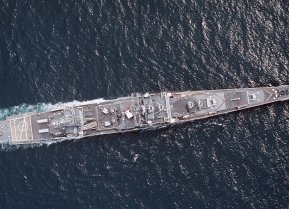The U.S. Navy Sent a Fleet of Iowa-Class Battleships to Strike North Korea
The Korean War provided what was thought to be a final operational hurrah for the Iowa-class battleships, the largest and heaviest ever built by the U.S. Navy.
Summary: The Korean War provided what was thought to be a final operational hurrah for the Iowa-class battleships, the largest and heaviest ever built by the U.S. Navy. These battleships, which included the USS Iowa, USS New Jersey, USS Missouri, and USS Wisconsin, were veterans of World War II and were quickly mobilized to support U.S., NATO, and South Korean forces against North Korean military advances. Operating with relative impunity due to the lack of a significant North Korean naval threat, they delivered critical naval fire support throughout the conflict.
Iowa-Class Battleships: Dominating the Seas in the Korean War
Once upon a time, battleships ruled the waves. These steel behemoths brimmed with heavy guns and could put down a devastating bombardment. World War Two was the last dance of the battleship. By the end of the conflict they were outshined by the emerging monster of the seas, the aircraft carrier.
But the breakout of the Korean War, just a few years after the largest conflict in history ended, gave one last opportunity for American battleships to show what they could do.
The Iowa-Class Battleships in Korea
Iowa-class battleships entered service at the end of World War Two, and they saw significant action both in the Atlantic and Pacific theaters. These were the largest and heaviest battleships in its arsenal, so the Navy kept the Iowa-class around when hostilities ended. When the Korean War broke out in 1950, they were ready to help.
All four battleships of the Iowa-class fought in Korea.
The USS Iowa, USS New Jersey, USS Missouri, and USS Wisconsin provided naval fire support to U.S., NATO, and South Korean forces. Since the North Korean military didn’t field a significant maritime force, U.S. and NATO naval forces were able to operate almost unpunished in the waters surrounding the Korean Peninsula.
All four warships completed multiple tours of duty in Korea, providing naval support fire to allied forces both in South Korea, and in North Korea when the war moved there.
Following the armistice and the cessation of hostilities in Korea, the U.S. Navy gradually decommissioned its Iowa-class battleships. The legendary USS Missouri, where Japan signed its surrender at the end of World War Two, went first in 1956. The New Jersey followed a year later. In 1958, the Iowa and Wisconsin both went into the reserve.
However, all four battleships would make a comeback and sail once more, fully armed. The New Jersey would fight in Vietnam, and all four would be refurbished and equipped with modern weapons, including Tomahawk land attack cruise missiles, to fight in the First Gulf War against Iraq.
The entire Iowa-class was finally decommissioned in the early 1990s. Some today serve as floating museums.

Heavily Armed Iowa-Class
The Iowa was the largest and heaviest battleship ever built by the U.S. Navy. With a displacement of 57,000 tons under full combat load, and a length of almost 900 feet, each warship was impressive. But it was their arsenal that made these ships stand out.
During the Korean War, Iowa-class battleships carried a total of 140 guns of all types. Main weaponry consisted of nine 16-inch (406mm) Mark 7 and two 5-inch (127mm) Mark 12 cannons. And for air defense, each warship carried 20 quad 40mm and 49 single 40mm Bofors guns.
Despite the heavy armament, the battleships were fast and could reach speeds of almost 40 miles per hour.
About the Author
Stavros Atlamazoglou is a seasoned defense and national security journalist specializing in special operations. A Hellenic Army veteran (national service with the 575th Marine Battalion and Army HQ), he holds a BA from the Johns Hopkins University, an MA from the Johns Hopkins’ School of Advanced International Studies (SAIS). He is pursuing a J.D. at Boston College Law School. His work has been featured in Business Insider, Sandboxx, and SOFREP.


